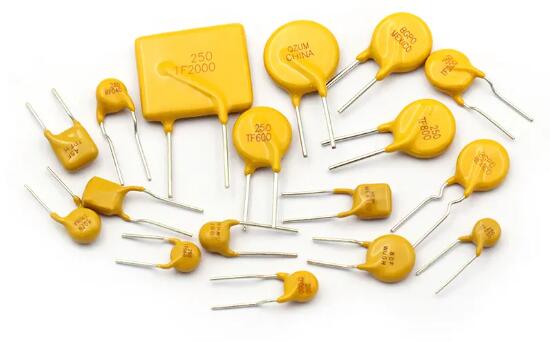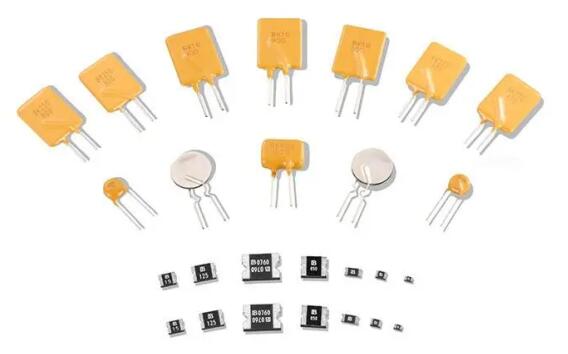one newly overcurrent protection component is an overcurrent electronic protection element, which is made of high molecular organic polymer under the conditions of high pressure, high temperature and vulcanization reaction, mixed with conductive particle material and processed by special process. The traditional fuse overcurrent protection can only protect once and needs to be replaced if it is burnt out. The self-healing fuse has the dual functions of overcurrent thermal protection and automatic recovery.
Application of polymeric positive temperature coefficient device (PPTC)
Ballast
Automobile self-recoverable Fuse,Fluorescent lamps need a ballast to generate high voltage and high current. The ballast controls the electrical characteristics of the fluorescent lamp.
When the lamp is turned on, the electronic ballast generates a high-voltage impact at both ends of the lamp to make the lamp light, and a self oscillation circuit is formed in the electronic ballast, which is controlled by a transistor.
Many electronic ballasts fail because of the lamp. When the lamp is short circuited, reaches its service life, or the lamp is taken off, overcurrent will occur, resulting in open circuit of the cathode of the lamp.
The load resistance becomes low due to the power factor. During starting, the ballast works more than three times under abnormal working current and high oscillation frequency; The switching circuit generates overcurrent, which leads to the failure of the ballast.
The self recovery fuse can provide the protection of the lamp when it reaches the service life and the fault protection of the transistor.
Because the ballast often fails because the upper and lower voltage switches of the transistor are opened at the same time, the fault protection of the transistor is of great significance.
Firstly, a passive electronic component has the performance of automatic recovery, which can reduce the number of product repair and service, so as to reduce the cost.
Secondly, because Auto-recoverable Fuse can act in a very short time to protect some sensitive resistors in the circuit, the reliability and service life of the ballast can be improved.
Third, the power consumption of self resetting fuse is very low, and it will not consume energy due to extreme heating under normal current working state. Under normal operating current, the resistance value is very small (usually only a few tenths of a Ohm), so no oscillation circuit will be formed.
Fourth, PTC Resettable Fuses has small volume and occupies small space on the circuit board, which is convenient for design.
Transformer
The fault of power supply equipment with transformer is mainly caused by overcurrent, which is usually caused by circuit short circuit or load reduction; In case of failure, the circuit will smoke and catch fire, so as to damage the circuit and interface.
The transformer of the lamp body of low-voltage halide lamp structure often fails due to short circuit.
If the installation and connection between the transformer and the lamp body are improper, it is easier to be damaged.
Because the lamps are used in parallel, the current is particularly large in case of short circuit.
Installing the self resetting fuse on the second coil of the transformer can prevent short circuit and overload faults.
Horn
The horn system has strict protection requirements.
The ordinary fuse only plays a one-time protective role in the horn, which increases the repair rate of the product; In addition, additional fuse boxes and wires increase the manufacturer's cost. In addition, the fuse used must also meet the specifications. A fuse of the wrong specification will damage the horn.
Installing circuit breaker is also a solution; However, before they are disconnected, they will make noise when they begin to disconnect.
Therefore, the best choice is self restoring fuse and self restoring fuse element.
The self resetting fuse is equivalent to a soft switch in the off state (high resistance state). When the fault is eliminated, it will automatically return to the state of low resistance path.
Battery
a. Mobile phone battery pack:
The key to the cell phone battery pack is its own application characteristics. This kind of battery is installed in a small, light and narrow box.
NiCd, NiMH and Li ion, the three main chemical batteries, are all packed in this universal box.
Generally, the working voltage of the battery pack is less than 10V, and the maximum charging voltage is 16V. The working voltage of the latest battery pack is even lower, between 3 ~ 4V.
This means that the packaging of the battery pack changes very quickly, from the welded strip to the mounting components on the printed circuit board.
Battery packs need circuit protection devices, such as vtp210g, which can maintain the current at about 1 ampere at 60C.
The lower the resistance of the protection circuit, the smaller the energy loss and the larger the space for component selection.
b. Cordless telephone battery: the current and voltage of cordless telephone are relatively small. Srp120, ltp070 and ltp100 are good overcurrent protection elements.
c. Radio communication battery: the current of radio communication credit is greater than that of mobile phone battery and less than that of laptop. LR4 series has a working current of 7.3 amps, small volume and light weight, which is very suitable for this application. SRP or LTP series with large operating current can also be applied.
Chemical battery
Chemical batteries are more and more widely used. The application of these components will make the battery pack have a better and lower cost protection device.
A. NiCd battery:
NiCd batteries with low impedance and stable chemical properties are not as sensitive to overcurrent as NIMH and Li ion batteries.
However, due to low loss, it is still widely used. However, in short-circuit or overcurrent states, their low internal resistance will lead to higher current flow.
Generally, the failure cause of these batteries is overcurrent rather than overheating, which is applicable to products applied by any battery material.
B. NiMH battery:
NiMH battery has higher energy density than NiCd battery.
When it exceeds 90C, these batteries are more prone to degradation.
VTP or LTP is more suitable for protecting this kind of battery than SRP / LR4 material.
According to the battery design method, SRP and LR4 can protect the battery, but LTP and VTP have stronger thermal conductivity.
C. Li ion battery:
Among all chemical batteries, Li ion battery has the highest energy density and the most sensitive chemical characteristics.
Circuit protection device shall be installed during use and charging.
The general protection device is an integrated circuit, but this is not the safest, because the integrated circuit itself may also cause short circuit or CMOS startup failure, making the protection device unsafe.
When it exceeds 90C, Li ion battery will also begin to degrade. Since the voltage of this battery is the largest, the requirements for circuit protection are more stringent.
Although LTP, SRP and other series have been used in the battery for a long time, the most suitable PTC element is VTP; For high-capacity Li ion batteries, the action time of LR4 series is shorter and more suitable than SRP series.












